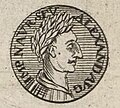File:Denarius of Severus Alexander (Musgrave).jpg
Denarius_of_Severus_Alexander_(Musgrave).jpg (422 × 429 pixels, file size: 45 KB, MIME type: image/jpeg)
Captions
Captions
Summary[edit]
| DescriptionDenarius of Severus Alexander (Musgrave).jpg |
Latina: Penates apud Devisas in Belgio Nostro Effossi Anno 1714, Tabula vi.
Et altero latere,
In vita Alexandri Severi. English: "Penates (Household Gods) Dug Up at Devises in Our Belgium in the Year 1714, Table 6."
And on the other side, The coin indicates that these Statues were placed in the Earth in the time of that Alexander.
|
| Date | (engraving); 1719 (book) |
| Source | Antiquitates Britanno-Belgicae, Praecipue Romanae, Figuris Illustratae..., Vol. I: De Belgio Britannico, Cap. XII |
| Author | William Musgrave |
| Other versions |
|
Licensing[edit]
| Public domainPublic domainfalsefalse |
|
This work is in the public domain in its country of origin and other countries and areas where the copyright term is the author's life plus 70 years or fewer. This work is in the public domain in the United States because it was published (or registered with the U.S. Copyright Office) before January 1, 1929. | |
| This file has been identified as being free of known restrictions under copyright law, including all related and neighboring rights. | |
https://creativecommons.org/publicdomain/mark/1.0/PDMCreative Commons Public Domain Mark 1.0falsefalse
IMP M AVR SEV. ALEXAND AVG
File history
Click on a date/time to view the file as it appeared at that time.
| Date/Time | Thumbnail | Dimensions | User | Comment | |
|---|---|---|---|---|---|
| current | 08:27, 11 June 2023 |  | 422 × 429 (45 KB) | LlywelynII (talk | contribs) | File:Virgo Vestalis (Musgrave).jpg cropped using CropTool. |
You cannot overwrite this file.
File usage on Commons
The following 3 pages use this file:



